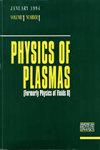Initial imprint effect on dynamic mitigation of plasma instability
IF 2.2
3区 物理与天体物理
Q3 PHYSICS, FLUIDS & PLASMAS
引用次数: 0
Abstract
We proposed a dynamic mitigation method for plasma instabilities based on a phase control to mitigate plasma instabilities and to smooth plasma non-uniformities [e.g., Phys. Plasmas, 19 (2012), 024503]. In plasmas, perturbation phase would be unknown in general, and instability growth rate is discussed. However, if the perturbation is introduced by, for example, an illumination non-uniformity of an input energy driver beam, the perturbation phase would be defined by the driver illumination non-uniformity itself. When the driver axis is controlled by its axis oscillation or wobbling motion, the perturbation phase would be known and controlled. By the superimposition of the growing phase-controlled perturbations, the overall plasma instability growth is mitigated. The dynamic mitigation method is effective to mitigate growths of various plasma instabilities. At the same time, it was found that the phase of the growing perturbations mitigated would be still defined by the initial imprint. In this paper, the initial imprint effect is focused on the dynamic mitigation mechanism in plasmas. The results in this paper demonstrate that the initial imprint effect is reduced by an appropriate pulse shaping of the oscillating or wobbling perturbation.初始印记对动态缓解等离子体不稳定性的影响
我们提出了一种基于相位控制的等离子体不稳定性动态缓解方法,以缓解等离子体的不稳定性并平滑等离子体的不均匀性[例如,Phys. Plasmas, 19 (2012), 024503]。在等离子体中,扰动相位一般是未知的,不稳定性增长速度也在讨论之列。然而,如果扰动是由输入能量驱动器光束的照明不均匀性等因素引入的,扰动相位将由驱动器照明不均匀性本身定义。当驱动轴由其轴摆动或摇摆运动控制时,扰动相位将是已知和可控的。通过增长的相位控制扰动的叠加,整个等离子体的不稳定性增长得到缓解。这种动态缓解方法能有效缓解各种等离子体不稳定性的增长。与此同时,研究还发现,所减缓的增长扰动的相位仍由初始印记决定。本文重点讨论了等离子体中的动态减缓机制的初始印记效应。本文的研究结果表明,通过对振荡或摆动扰动进行适当的脉冲整形,可以减少初始印记效应。
本文章由计算机程序翻译,如有差异,请以英文原文为准。
求助全文
约1分钟内获得全文
求助全文
来源期刊

Physics of Plasmas
物理-物理:流体与等离子体
CiteScore
4.10
自引率
22.70%
发文量
653
审稿时长
2.5 months
期刊介绍:
Physics of Plasmas (PoP), published by AIP Publishing in cooperation with the APS Division of Plasma Physics, is committed to the publication of original research in all areas of experimental and theoretical plasma physics. PoP publishes comprehensive and in-depth review manuscripts covering important areas of study and Special Topics highlighting new and cutting-edge developments in plasma physics. Every year a special issue publishes the invited and review papers from the most recent meeting of the APS Division of Plasma Physics. PoP covers a broad range of important research in this dynamic field, including:
-Basic plasma phenomena, waves, instabilities
-Nonlinear phenomena, turbulence, transport
-Magnetically confined plasmas, heating, confinement
-Inertially confined plasmas, high-energy density plasma science, warm dense matter
-Ionospheric, solar-system, and astrophysical plasmas
-Lasers, particle beams, accelerators, radiation generation
-Radiation emission, absorption, and transport
-Low-temperature plasmas, plasma applications, plasma sources, sheaths
-Dusty plasmas
 求助内容:
求助内容: 应助结果提醒方式:
应助结果提醒方式:


